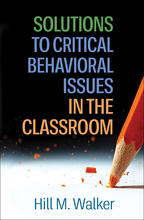Solutions to Critical Behavioral Issues in the Classroom
Hill M. Walker
I. Strategies for Solving Problems with Students Who Do Not Meet Teacher Expectations for Appropriate Classroom Behavior
1. Enhancing Student Compliance with Teacher Requests and Directives
2. Improving Student Completion of Seatwork Assignments According to Instructions
3. Motivating Students to Produce Academic Work of Acceptable Quality for Their Skill Level
4. Teaching Students to Have Positive Interactions/Conversations with Peers
5. Developing Students’ Ability to Follow Classroom Rules and Behavioral Expectations
6. Helping Students Cope with Disappointment, Frustration, and Failure
II. Strategies for Teaching Students How to Avoid and Reduce Challenging Behavior
7. Teaching Students to Avoid Damaging Others’ Property and Possessions
8. Reducing Insubordination and Enhancing Students’ Respect for the Teacher
9. Teaching Students Not to Have Tantrums When Unable to Get Their Way
10. Reducing Students’ Aggression in School Contexts
11. Coping with Teacher Defiance When Managing the Classroom Behavior of Oppositional Students
12. Addressing Student Lying, Cheating, and Stealing at School
III. Strategies for Increasing Desirable Behavior, Decreasing Undesirable Behavior, and Sustaining Achieved Behavior Change Over Time
13. How to Increase Desirable Student Behavior
14. How to Decrease Undesirable Student Behavior
15. How to Sustain Behavioral Change(s) over Time and across Settings
Appendix 1. Short Form of The SBS Inventory
Appendix 2. Recommended Additional Resources for Use by Teachers
Appendix 3. Handout for Parents on How to Debrief Daily with Their Children about School
Appendix 4. Coping with the Impact of Psychiatric Disorders in Schooling
References
Index



